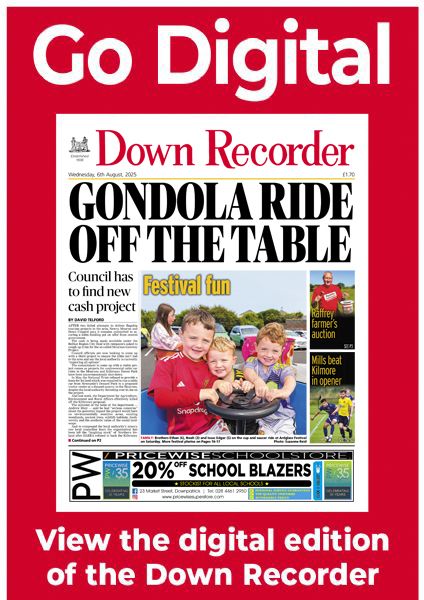Last action of a Ballynahinch dynasty
Last action of a Ballynahinch dynasty
6 June 2012
IN Ballynahinch in 1912, the century-old Ker dynasty at Montalto had come to an end. The family had sustained a series of bankruptcies and the ancestral estate was put in receivership. In March 1912, the Montalto mansion and estate were sold to the Earl of Clanwilliam and his bride who were now keen to take possession as the new Lady Clanwilliam refused to live at Gill Hall near Dromore because it had too many ghosts.
One of the last acts of the Ker family in Ballynahinch was to sign the Ulster Covenant on Saturday, September 28, 1912.
Richard and his son David signed in the town hall on the Square which is now the Market House and up until then a Ker family property. His wife Edith and Helena and Beatrice Ker went to the women’s poll at Ballynahinch railway station, supervised by Mrs. Margaret Scott.
The Montalto sale had been supervised by a Downpatrick solicitor Col. Robert Hugh Wallace, agent for the Ker family’s creditors.
Colonel Wallace was a man of many parts. Called to the bar by the Inner Temple in 1886, he had commanded the 5th Battalion Royal Irish Rifles during the Boer War and was now Orange Grand Master for Belfast.
In 1912, he was a principal founder of the Ulster Volunteer Force and had personally tested the UVF rifles before Major Fred Crawford smuggled them into Larne in 1914.
In Ballyna-hinch, Colonel Wallace was particularly solicitous of the new Congregational Church formed in 1902 by a coalition of politically-minded local Presbyterians. He secured a site for their first temporary church on the edge of the Ker demesne, where the Montalto Medical Centre is now located. His wife helped lay the church’s foundation stone.
When the congregation made plans for a more permanent building in 1910, he secured a site for them on the other side of Dromore Road on the ground of the former Horse Fair. Colonel Wallace even gave permission for the church’s Shooting Club to hold competitions in Ballynahinch Market House. Nothing was too much trouble for him where this new congregation was concerned.
By 1914 there was no doubting the political outlook of the new occupant of Montalto, Lord Clanwilliam. An officer in the Royal Horse Guards he had been severely wounded in the Boer War. In Ballynahinch he had a warm relationship with the newly-formed UVF, as shown in a report in the Down Recorder on February 2, 1914.
It read: “Last night, under the auspices of Ballynahinch Unionist Club, an imposing demonstration was held in the courthouse. Lord Clanwilliam, president, occupied the chair, and he was accompanied on the platform by Lady Clanwilliam, Captain James Craig MP and Mrs. Craig, Mr. Hall-Thompson, Mr. and Mrs. James Hurst and Mr. S. B. Combe.
“At 7.15pm, Nos. 1 and 2 companies of the 3rd Battalion of the East Down Regiment UVF, with the ladies of the St. John’s Ambulance Class, marched to Montalto house. There, a guard of honour was formed for Captain Craig and other guests.”
James Hurst was proprietor of Drumaness Mill and one of the largest employers in the Ballynahinch area. Barry Combe was a Lieutenant in the North Irish Horse and succeeded Richard Ker as Master of the Co. Down Staghounds. A scion of the Combe Barbour & Combe engineering dynasty, he lived on the edge of the Montalto estate on the road to Spa. At that time the stags were kept in a deer park at Montalto within sight and sound of the Church Road.
The conjunction of Lord Clanwilliam, Captain Craig and Messrs Hurst and Combe on one platform was significant. It was evidence that in 1914 the propertied classes in Ballynahinch were determined to resist Home Rule by military means.
Lord Clanwilliam’s heir was born later the same year on June 6 1914. To mark the occasion the Ballynahinch UVF erected a banner over the Eagle Gates at the Dromore Street entrance to the Montalto estate proclaiming “Ballynahinch Volunteers Welcome Lord Gilford.”
In April 1914 the UVF rifles requisitioned by Colonel Wallace arrived at Larne, Bangor, and Donaghadee. But they were never used. On July 28 1914, Great Britain went to war with Germany and the issue of Home Rule was deferred for the duration.
The first Bally-nahinch casualty in the Great War was Lieuten-ant Barry Coombe, killed on September 30 1914. He had volunteered for a highly dangerous solo reconnaissance of German lines. When surrounded he refused to surrender and died fighting. Aged 35, he left behind a wife and young family. His name appears as number five on the list of fallen on Bally-nahinch War Mem-orial.
• Admis-sion to next Tuesday night’s cross-community event in the Market House which starts at 7.30pm is free.


